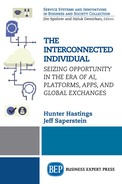As authors, we have tried, over the past dozen years, to provide readers with insights into the impact of new technologies on their business practices. The Interconnected Individual is significantly different from our past work.
The focus in our first two books was on how technology was transforming the marketing discipline: The New Marketing Mission and Improve Your Marketing to Grow Your Business. Subsequently, we explored how demand creation was being fundamentally changed through the application of technologies in new organizational designs, and in a new model for co-creation of value with customers: Bust the Silos: Opening Your Organization for Growth and Service Thinking: The Seven Principles to Discover Innovative Opportunities.
These prior works were written for business executives, mostly in large organizations, who were aiming to increase growth and opportunity based on systems and principles in a relatively predictable marketplace economy.
The Interconnected Individual is directed to a different audience in a different technological era and answers a different challenge: the effects of artificial intelligence (AI), cloud computing, data and analytics, social networks, platforms, and mobile apps on work, business, and life.
We all face a great question: “How will AI change the world as we know it, and how do we each find our role to improve the common good?” Tim O’Reilly has suggested that we will experience either astonishment with what will become possible to create a better world or dismay with the chaos and dysfunction of systems that are out of human control and destructive to our societies. “It isn’t technology that puts people out of work; it’s the decisions we make about how to apply it.”1
We believe that the future has great promise, and we are optimistic that everyone, in all groups and all geographic regions, can benefit from the adjacent possibilities that technology affords. Our focus is on how people, interconnected through platforms and apps on global exchanges, can create the new institutions, organizations, career paths, and opportunities for themselves and others.
Our optimism starts from individual self-reliance. The positive individual entrepreneurial mind-set can be enhanced by continuous energetic application in building lifelong professional networks, commitment to lifelong learning, continuous up-skilling to use new tools, a willingness to pivot for opportunities, openness to change, and engagement in the journey of values-based career navigation.
In the past, success favored the connected individual to the exclusion of most people. Many of the necessary elements for access to opportunity included where you lived, where you went to school, your parents’ status in the social hierarchy, your structural connection to influential people in clubs and organizations, the companies on your resume, and your connection to favored groups based on ethnicity, race, marital status, and sexual orientation.
Today, we see a new era for the interconnected individual, who can break the shackles of hierarchy, status quo, and legacy biases. We see the promise of democratization of opportunity for those who seize it. We see new rules of the game, as the result of platforms, apps, global exchange networks and cloud computing, that augment individual capacity and enable individual opportunity. Those who are interconnected will have a new chance to participate in the global marketplace and thereby to engage in fulfilling work that matters to them. Our hope is that we can suggest a conceptual framework, approaches, and tools that can open the exploration for those who want to succeed by seizing individual opportunity in the interconnected era.
This book is dedicated to them.
___________________
1T. O’Reilly. 2017. What’s the Future and Why It’s Up to Us (New York, NY: Harper Collins Publishers), p. 371.
